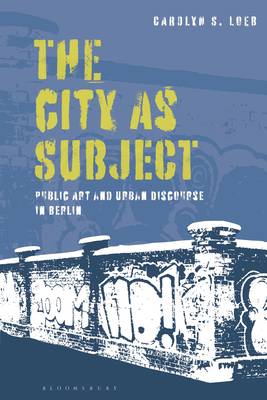
- Afhalen na 1 uur in een winkel met voorraad
- Gratis thuislevering in België vanaf € 30
- Ruim aanbod met 7 miljoen producten
- Afhalen na 1 uur in een winkel met voorraad
- Gratis thuislevering in België vanaf € 30
- Ruim aanbod met 7 miljoen producten
Zoeken
€ 67,95
+ 135 punten
Omschrijving
In The City as Subject, Carolyn S. Loeb examines distinctive bodies of public art in Berlin: legal and illegal murals painted in West Berlin in the 1970s and 1980s, post-reunification public sculptures, and images and sites from the street art scene. Her careful analyses show how these developed new architectural and spatial vocabularies that drew on the city's infrastructure and daily urban experience. These works challenged mainstream urban development practices and engaged with citizen activism and with a wider civic discourse about what a city can be.
Loeb extends this urban focus to her examination of the extensive outdoor installation of the Berlin Wall Memorial and its mandate to represent the history of the city's division. She studies its surrounding neighborhoods to show that, while the Memorial adopts many of the urban-oriented vocabularies established by the earlier works of public art she examines, it truncates the story of urban division, which stretches beyond the Wall's existence. Loeb suggests that, by embracing more multi-vocal perspectives, the Memorial could encourage the kind of participatory and heterogeneous construction of the city championed by the earlier works of public art.
Loeb extends this urban focus to her examination of the extensive outdoor installation of the Berlin Wall Memorial and its mandate to represent the history of the city's division. She studies its surrounding neighborhoods to show that, while the Memorial adopts many of the urban-oriented vocabularies established by the earlier works of public art she examines, it truncates the story of urban division, which stretches beyond the Wall's existence. Loeb suggests that, by embracing more multi-vocal perspectives, the Memorial could encourage the kind of participatory and heterogeneous construction of the city championed by the earlier works of public art.
Specificaties
Betrokkenen
- Auteur(s):
- Uitgeverij:
Inhoud
- Aantal bladzijden:
- 288
- Taal:
- Engels
Eigenschappen
- Productcode (EAN):
- 9781350258648
- Verschijningsdatum:
- 24/08/2023
- Uitvoering:
- Paperback
- Formaat:
- Trade paperback (VS)
- Afmetingen:
- 156 mm x 234 mm
- Gewicht:
- 399 g

Alleen bij Standaard Boekhandel
+ 135 punten op je klantenkaart van Standaard Boekhandel
Beoordelingen
We publiceren alleen reviews die voldoen aan de voorwaarden voor reviews. Bekijk onze voorwaarden voor reviews.








